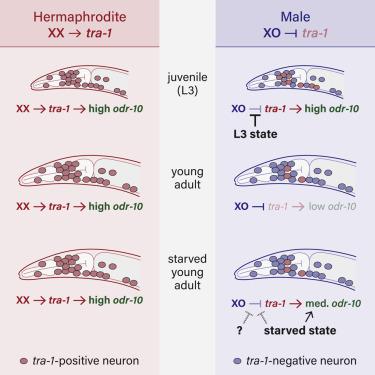Current Biology ( IF 9.2 ) Pub Date : 2020-07-23 , DOI: 10.1016/j.cub.2020.07.007 Hannah N Lawson 1 , Leigh R Wexler 2 , Hayley K Wnuk 1 , Douglas S Portman 3

|
Biological sex in animals is often considered a fixed, individual-level characteristic. However, not all sex-specific features are static: for example, C. elegans males (XO) can sometimes exhibit hermaphrodite (XX)-like feeding behavior [1, 2]. (C. elegans hermaphrodites are somatic females that transiently produce self-sperm.) Essentially all somatic sex differences in C. elegans are governed by the master regulator tra-1, whose activity is controlled by chromosomal sex and is necessary and sufficient to specify the hermaphrodite state [3]. One aspect of this state is high expression of the chemoreceptor odr-10. In hermaphrodites, high odr-10 expression promotes feeding, but in males, low odr-10 expression facilitates exploration [4]. However, males suppress this sex difference in two contexts: juvenile males exhibit high odr-10 expression and food deprivation activates odr-10 in adult males [4, 5, 6]. Remarkably, we find that both of these phenomena require tra-1. In juvenile (L3) males, tra-1 is expressed in numerous neurons; this expression diminishes as individuals mature into adulthood, a process that requires conserved regulators of sexual maturation. tra-1 remains expressed in a small number of neurons in adult males, where it likely has a permissive role in odr-10 activation. Thus, the neuronal functions of tra-1 are not limited to hermaphrodites; rather, tra-1 also acts in the male nervous system to transiently suppress a sexual dimorphism, developmentally and in response to nutritional stress. Our results show that the molecular and functional representation of sexual state in C. elegans is neither static nor homogeneous, challenging traditional notions about the nature of biological sex.
中文翻译:

线虫神经系统中性状态的动态、非二元规范。
动物的生物性别通常被认为是固定的、个体水平的特征。然而,并非所有特定于性别的特征都是静态的:例如,线虫雄性 (XO) 有时会表现出雌雄同体 (XX) 样的摄食行为 [1, 2]。(C. elegans雌雄同体是暂时产生自体精子的体细胞雌性。)基本上所有C. elegans 的体细胞性别差异都由主调节器tra-1控制,其活动受染色体性别控制,并且是必要和充分指定雌雄同体状态 [3]。这种状态的一个方面是化学感受器odr-10 的高表达。在雌雄同体中,高odr-10表达促进进食,但在雄性中,低odr-10表达促进探索 [4]。然而,雄性在两种情况下会抑制这种性别差异:幼年雄性表现出高odr-10表达,而食物匮乏会激活成年雄性中的odr-10 [4, 5, 6]。值得注意的是,我们发现这两种现象都需要tra-1。在幼年 (L3) 雄性中,tra-1在许多神经元中表达;随着个体成熟到成年,这种表达会减少,这一过程需要保守的性成熟调节器。tra-1仍然在成年男性的少数神经元中表达,它可能在odr-10 中发挥作用激活。因此,tra-1的神经元功能不仅限于雌雄同体;相反,tra-1还在男性神经系统中起作用,在发育过程中和对营养压力的反应中暂时抑制性别二态性。我们的结果表明,秀丽隐杆线虫中性状态的分子和功能表征既不是静态的也不是同质的,挑战了关于生物性别性质的传统观念。


























 京公网安备 11010802027423号
京公网安备 11010802027423号